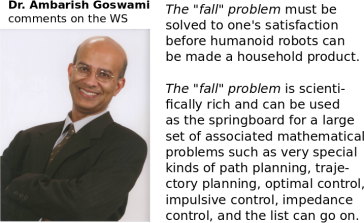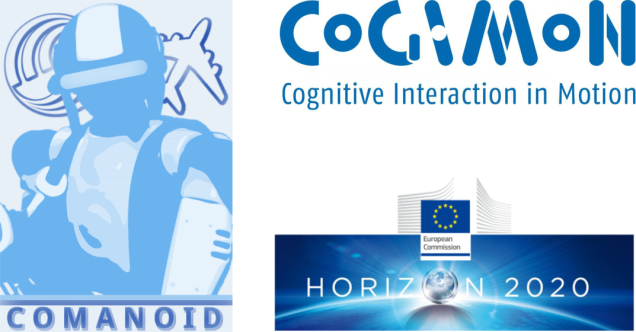Objectives and Motivation
 Research on humanoid robots has focused mainly on reliable perception, planning, and control methods for completing challenging tasks. The DARPA Robotics Challenge 2015 showed that when the tether is removed, legged robots may inevitable fall over during a task in an unstructured environment; either when they walk on a flat or rough terrain, or when they are cutting a wall with a drill, opening a door, and turning a valve. In a lot of cases if a humanoid robot falls over, it may end up with a serious damage for itself or the environment. If not, the robot in a real world scenario should recover, stand up, and complete the task. Being able to detect such a fall, apply the appropriate actions to prevent a big damage both on the robot and the environment around it, and recover if possible, are necessary for a real world application, where humanoid robots will need to deal with even rougher terrain and more complicated manipulation tasks under significant uncertainty either for static or dynamically changing environments.
Research on humanoid robots has focused mainly on reliable perception, planning, and control methods for completing challenging tasks. The DARPA Robotics Challenge 2015 showed that when the tether is removed, legged robots may inevitable fall over during a task in an unstructured environment; either when they walk on a flat or rough terrain, or when they are cutting a wall with a drill, opening a door, and turning a valve. In a lot of cases if a humanoid robot falls over, it may end up with a serious damage for itself or the environment. If not, the robot in a real world scenario should recover, stand up, and complete the task. Being able to detect such a fall, apply the appropriate actions to prevent a big damage both on the robot and the environment around it, and recover if possible, are necessary for a real world application, where humanoid robots will need to deal with even rougher terrain and more complicated manipulation tasks under significant uncertainty either for static or dynamically changing environments.
This workshop will provide a platform for researchers from all areas in robotics to disseminate and exchange ideas, evaluating their advantages and drawbacks. This will include from the mechanical design and biomechanics to the perception, planning, and whole-body control methods on real robots and simulations for fall detection, damage prevention, and recovery actions in a falling over scenario. The aim is to foster collaboration among researchers that are working on humanoid robots to advance the very limited state-of-the-art work in this area.
We organize a half-day workshop consisting of a mixture of presentations on topics including design, sensing, perception, planning, biomechanics, and motion generation for humanoid robots designed to work indoors and outdoors. To stimulate interaction, we will also organize a poster session to encourage the participation of young researchers and promote the discussion with the speakers and the audience. Moreover we will allocate adequate time for questions and discussion to make the workshop as interactive as possible.
This workshop is the second to be organized on this topic, after our first successful attempt in ICRA 2016 (“Legged Robot Falling: Fall Detection, Damage Prevention, and Recovery Actions”), with a bigger focus on humanoid robots. This workshop is realated also to the IROS’15 workshop on “The Path to Success: Failures in Real Robots” and the ICRA’15 workshop o “Dynamic Locomotion and Balancing of Humanoids: State of the Art and Challenges”, which were focused more on analyzing the cause of a fall, the fall recovery for toy-robots, and balancing. This workshop will focus on the action to follow an inevitable fall after it has been detected. We believe that such a workshop will attract a large number of participants and promote interaction and collaboration, given the emergent interest in humanoid failures rising also from the DRC 2015 results.
Topics of Interest:
- mechanical design for a falling scenario and soft robotics
- robotic simulation for falling
- exteroceptive and proprioceptive perception for fall detection
- fall planning and recovery
- damage prevention control
- collision avoidance and self-collision avoidance
- reactive behaviors and emergency behaviors
- biomechanical analysis of human fall detection
- whole-body control fall/recovery strategies
Support of IEEE-RAS and RSJ Technical Committees
This workshop is supported by the following IEEE RAS Technical Committees:
- IEEE RAS Technical Committee on Humanoids Robotics as confirmed as confirmed by the Technical Committee co-chairs Katsu Yamane, Giorgio Metta, and Tomomichi Sugihara.
- IEEE RAS Technical Committee on Algorithms for Planning and Control of Robot Motion as confirmed by the Technical Committee co-chairs Sertac Karaman and Lydia Tapia.
- IEEE RAS Technical Committee on Robotics and Automation in Nuclear Facilities, as confirmed by the Technical Committee co-chairs William R. Hamel, Hajime Asama, Raja Chatila, and Yoshihiko Nakamura.
- IEEE RAS Technical Committee on Whole-Body Control, as confirmed by the Technical Committee co-chairs Federico Moro, Jaeheung Park, and Luis Sentis.
This workshop is supported by the following RSJ Special Interest Group:
- RSJ Special Interest Group on Humanoid Robotics, as confirmed by Tomomichi Sugihara.
We would also like to thank Prof. Ambarish Goswami, who, as in our previous workshop event on this topic, helped a lot on the organization. His priceless support on the topic, given that he is one of the first to study humanoid robot falling strategies, was very important.
Acknowledgement
This workshop is supported by:
- The ICT-23-2014 CogIMon European Commission H2020 project (no. 644727): https://cogimon.eu
- The ICT-23-2014 COMANOID European Commission H2020 project (no. 645097): www.comanoid.eu

